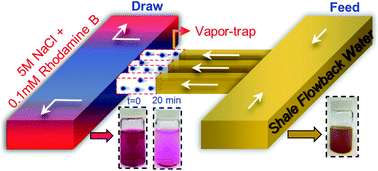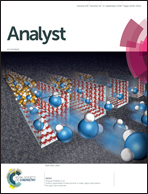Surface dependent enhancement in water vapor permeation through nanochannels†
Abstract
Selective permeation of water vapor over liquid phase water through hydrophobic conduits finds broad use in separation processes, including desalination and membrane distillation. The tangential momentum accommodation coefficient (TMAC), a fundamental parameter that dictates momentum changes to a molecule colliding with a wall remains unknown for water vapor at room temperature and pressure conditions. Here, a nanofluidic platform with tunable hydrophobic regions that selectively barricaded flow of liquid water was patterned within glass nanochannels. The surface functionalization with an alkyltrichlorosilane led to either a fluoride or a methyl terminal group generating partially hydrophobic regions along the length of the nanochannels. Differential osmotic pressure solutions on either side of the hydrophobic region cause an isothermal evaporation–condensation process, which drives net water vapor transport from higher to lower vapor pressure solution, similar to osmotic distillation. Water vapor transport under such conditions for the 80 nm deep nanochannels was in the transitional regime with the Knudsen number ∼O(1). The TMAC was estimated experimentally to be of the order of 10−4–10−3 for both the hydrophobic coatings leading to a near-elastic collision of H2O molecules with the nanochannel walls. Use of the low TMAC surfaces was evaluated in two proof-of-concept technology demonstrations: (1) osmotic distillation using hyper-saline (brine) 3 M Utica shale flowback water as both the feed and draw and (2) separation of trace amounts of toluene and chloroform from water at high flux and selectivity. The results reported here likely provide new insights in designing hydrophilic–hydrophobic junctions for nanoscale liquid/vapor fluid transport with enhanced flux and selectivity.

- This article is part of the themed collection: Analyst Recent HOT articles


 Please wait while we load your content...
Please wait while we load your content...
